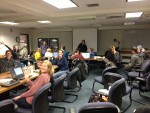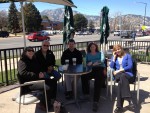The cycling of carbon is an important aspect of the function of terrestrial (land-based) and aquatic (water-based) ecosystems across the Long Term Ecological Research (LTER) network. Therefore the transport of carbon (C) is a critical component of ecosystem carbon accounting from terrestrial to aquatic ecosystems. The chemical properties of the major pools of organic carbon dissolved in water and stored in soils can play a key role in determining the flow of carbon from the landscape and the key processes controlling carbon cycling.
However, finding tools to characterize functional pools of dissolved organic carbon that relate to its movement and stability has proven elusive. Recent research has suggested that specific optical properties—i.e., the ways in which this organic matter absorbs light across the ultraviolet (UV) and visible spectrum and then fluoresces (emits light at a higher wavelengths)—can indicate the initial sources of organic matter and the transformations that have occurred. They can also be readily measured, as exemplified by the growing pool of literature in diverse fields of environmental science and engineering in which optical properties of organic matter have been applied.
With this in mind, a workshop sponsored by the LTER Network Office (LNO), Linking Aquatic and Soil Organic Matter across Ecosystems, was held May 2-3 at the Institute of Arctic and Alpine Research (INSTAAR) at the University of Colorado-Boulder. A steering committee comprising Diane McKnight (McMurdo and Niwot Ridge LTER), Rudolf Jaffe (Florida Coastal Everglades LTER), Kate Lajtha (Andrews LTER), and Hiliary Hartnett (Central Arizona-Phoenix LTER), assisted by Jessica Ebert (McMurdo LTER) and Kaelin Cawley (Florida Coastal Everglades LTER), organized the workshop, including the pre-workshop submission of optical data by participants. The goals of this workshop were to advance the application of optical properties in studying soil organic matter/dissolved organic matter (SOM/DOM) linkages between terrestrial and aquatic ecosystems; develop a synthesis of studies of soil water content, soluble SOM, and DOM across diverse LTER sites: and develop ways to incorporate optical data from LTER monitoring programs into the Network Information Systems (NIS). The 26 participants included university professors, research scientists, post docs, and PhD students from 15 different institutions and 13 separate LTER sites.
In preparation for the workshop, Jessica Ebert received a LNO graduate student fellowship and conducted a 2-day pre-workshop training session. This hands-on training focused on techniques for obtaining 3-D fluorescence spectra, referred to as excitation and emission matrices or EEMs, and statistical analysis of EEMs through Parallel Factor Analysis (PARAFAC). The participants learned how to analyze EEMs using existing PARAFAC models, which are based on analysis of EEMs from surface and ground water sources from several LTER sites. The training session attracted 17 participants, including 14 masters and PhD students, two post docs, and a research assistant, many of whom also participated in the subsequent workshop. Ebert has continued to lead the post- workshop analysis of existing spectral data and new soil and water samples contributed by participants.
The INSTAAR workshop addressed the following research questions:
- Can we see similarities between optical properties of DOC on land and in water?
- Can we use optical properties of soil DOC extracts to predict DOC flux to streams?
- What is the connectivity between (dissolved and potentially dissolved) organic matter pools in the environment?
- What are the environmental drivers of both quantity and quality of the organic matter?
- How is that affected by disturbance events (land use change, climate, storm events, pine beetle kill, natural and anthropogenic, impoundments)?
- Does short term temporal variation matter over long time scales?
- What is the time-scale of the variability?
- Where is convergence of organic matter characteristics along the hydrologic flow path within catchments?
- What are the similarities in and differences in where this convergence is happening between various sites?
The second morning of the workshop saw post-docs and graduate students take over the leadership of the workshop. This group developed a plan to collect surface water, soil, and lysimeter data, when available, from the various LTER sites to develop an All LTER PARAFAC model that can be used to characterize optical properties of soil and water samples across LTER sites. The plan was subsequently shared with the steering committee and all the participants then worked together to develop a detailed plan of action, which is currently underway. Emails were sent out to all LTER sites informing them of the plan, and of the 10 sampling kits sent out, three sites have returned water and soil samples while one other site was expected to do so at the time of publishing this article. Once enough kits have been returned another round of kits will be sent out to the remaining sites that have agreed to participate.

 Enlarge this image
Enlarge this image
